Emperor scorpions have cemented their place as one of the gentlest of their species, making them particularly sought after amongst the growing popularity of other scorpions as pets.
While the emperor scorpion stands out as one of the largest scorpion breeds, measuring in at a whopping 23cm in some cases, it is incredibly docile and much more likely to pinch than sting.
This unique behavior makes the emperor scorpion a brilliant pet for beginners.
Despite the emperor scorpion’s temperament and ease of care, it is still essential to understand the species’ needs to elongate its life span.
In this article, we will outline everything that a new owner needs to know about the emperor scorpion. We will delve into behavior, feeding, safety, and other essential facts to ensure that new owners are well prepared for their journey as an emperor scorpion carer.
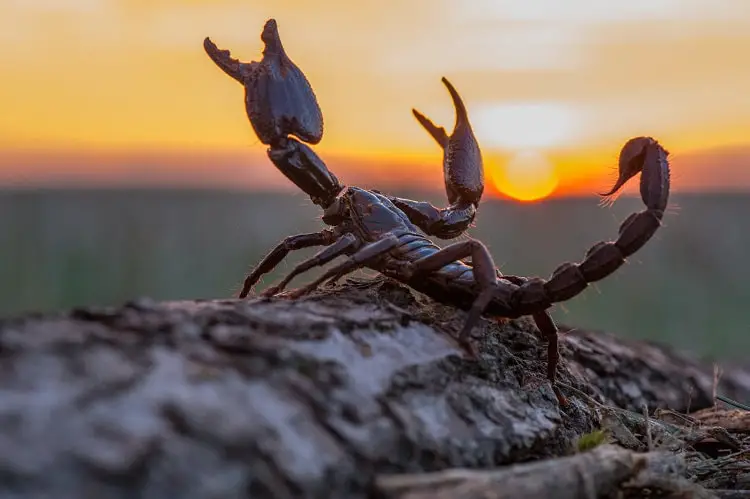
Overview
The emperor scorpion is a species of scorpion bearing the scientific name Pandinus Imperator that originates from West Africa, more specifically the savannas and rainforests of the region.
Initially introduced and described by C.L. Koch in 1842, the species remained relatively unknown until the works of Tamerian Thorell allowed for the recognition of the Pandus genus in 1876.
Keeping in line with other scorpion species that are somewhat long-lived when compared to other invertebrates, the emperor scorpion can survive for anywhere between five to ten years when kept as a pet.
The emperor scorpion sports a body that at first glance will appear completely black, but much like others of its kind, the emperor scorpion will glow blue or a light shade of green when under ultraviolet light.
While the emperor scorpion is not listed on the IUCN Red List as an endangered species, emperor scorpions were placed on the CITES II species list in February 1995 due to dwindling numbers.
As the lessening of the species was blamed heavily on sale and overcollection, countries have put in place rules that require permits for the import and export of the emperor scorpion species.
Due to these rules and regulations, wild trading of emperor scorpions is banned in many countries, and the only way to legally own one is to purchase those bred in captivity.
Therefore, to ensure that your scorpion is legal, you must carefully research the breeder to make sure you are not participating in the trade of illegal emperor scorpions.
Emperor scorpions utilize two approaches to protection and aggression, that is the use of their pedipalps, better known as their claws, and their stinger.
While emperor scorpions are not particularly aggressive when they feel threatened, they will react. Usually, this reaction takes the form of a pinch.
Using their large claws, emperor scorpions will seek to clamp down on any threat within their vicinity.
While a pinch will hurt, it is often no more dangerous than a nip from a kitten or a puppy, functioning more as a warning than an actual source of danger.
In rare cases, emperor scorpions will use their stingers, but much like a bee sting, this is only ever dangerous to people who are allergic to the venom. Usually, emperor scorpion stings require no medical attention.
However, despite these two defense mechanisms, emperor scorpions typically will not seek to cause any harm to a handler.
This docility has led to a rapid increase in desire for the species as a pet. Still, it is recommended that beginners acknowledge that while not aggressive, the scorpion rarely enjoys handling and should be left alone unless absolutely necessary.
Another essential factor to understand before purchasing an emperor scorpion is habitat.
When creating a habitat for your emperor scorpion is vital to remember that the species lives and thrives in hot and humid conditions.
Therefore any habitat should mimic these conditions to ensure that your pet has a long and comfortable life. In particular, emperor scorpions require a 75% humidity level to effectively replicate the conditions of their natural habitat.
To help retain any moisture added to the habitat, keepers can utilize sphagnum moss to cover and protect the liquid added to whatever material is used as the base for the enclosure.
One of the best options for housing emperor scorpions is the use of glass aquariums. Not only does this approach allow you to easily monitor your pet, but it can also help you to quickly identify areas of mold that may accumulate on your journey to provide the perfect humidity for your pet.
Emperor scorpions can be kept as a single pet or as a group. In the case of a single scorpion, a 10-gallon tank would be appropriate. However, for groups, the glass tank should be at least 20-gallons.
As emperor scorpions like to burrow and hide, soil and peat should be available to an appropriate degree to allow the scorpion to retreat to its safe spot if required. As such, no less than three inches of the material should be on hand at any time within the enclosure.
Advantages And Disadvantages of Owning An Emperor Scorpion
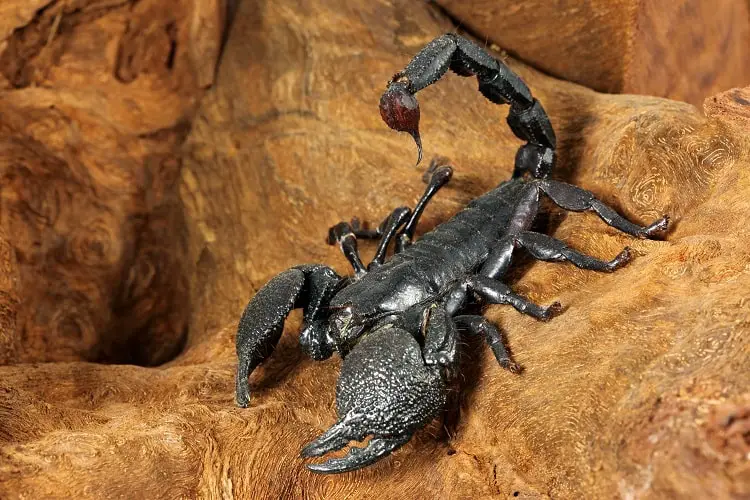
Pros:
- Emperor scorpions are long-lived and generally docile
- Emperor scorpions are perfect for new users
- Emperor scorpions can be kept individually or as a part of a group
Cons:
- Emperor scorpions have stringent humidity requirements
- An emperor scorpion’s sting can cause serious damage for anyone allergic to their venom
- Emperor scorpions usually do not like being handled
Appearance
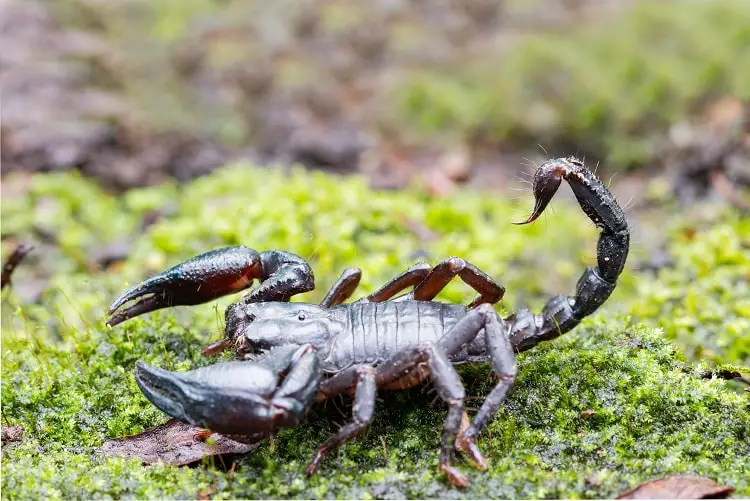
As the gentle giant of the scorpion family, it is no wonder where the emperor scorpion got its name. With the largest of its kind standing at a stunning 23cm, the emperor scorpion does not need help standing out in a crowd.
Coated with a glossy black exterior, the emperor scorpion presents an intimidating appearance that belies its gentle temperament.
The scorpion boasts a set of large reddish-black claws that present a hefty challenge to any creature seeking to harm it. On the other end of the scorpion’s body is its metasoma or tail.
This intimidating weapon is colored in hues of red and curved slightly over the scorpion’s body ending in a sharp stinger that it uses to inject its venom.
The scorpion’s tail is covered in fine hairs that it uses to detect predators and prey.
It is often quite challenging to differentiate between male and female emperor scorpions, especially when they are young. While female scorpions are larger in some cases, size cannot always be used to identify a specific gender.
One of the most tried and accurate methods of gender identification in emperor scorpions is by examining the scorpion’s pectines.
A scorpion’s pectines are ventromedial, feathery appendages that brush the ground as the scorpion walks. They are believed to help in the finding of food and the directing of mating.
Located on the underside of the scorpion, pectines develop differently depending on the emperor scorpion’s gender.
Females boast pectines that are broader in width and place further apart on their body, while male pectines are narrower and set closer together.
While gender will not matter much in the case of a single scorpion household, it is crucial when groups are kept together.
While neither gender of emperor scorpions is particularly aggressive, females have been known to eat males after mating.
While an excess of food might prevent this, it is no guarantee, and you might lose a scorpion if care is not exercised.
In addition, like many other species, female scorpions with young can exhibit a higher level of aggression in an effort to protect their family from what they identify as an intruder.
Care Guide
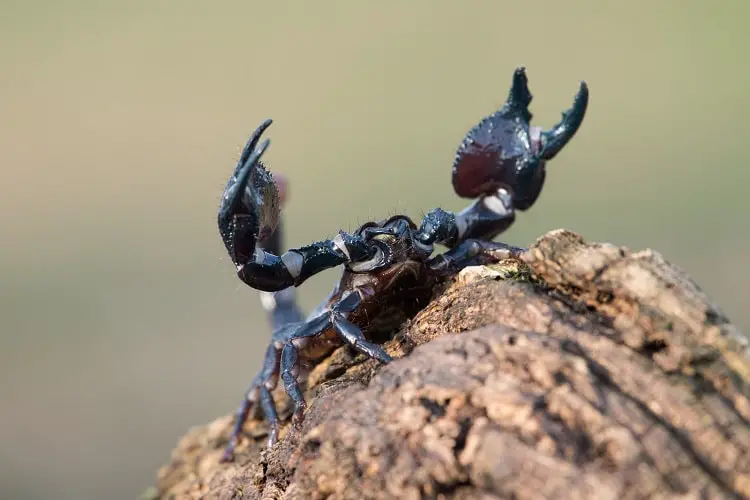
One of the most important aspects of keeping an emperor scorpion is providing the appropriate enclosure for the species to thrive in.
While the temperament of the scorpion may be easy to gauge and adapt to, the enclosure conditions must follow a rigid outline to ensure your pet’s survival.
Temperature is critical when caring for your emperor scorpion. As the species are cold-blooded, they require temperatures that range between 70 degrees Fahrenheit to 90 degrees Fahrenheit to function.
These temperatures can be achieved and maintained through the use of reptile-geared heating mats. The mats should be sized and positioned in such a way that your scorpion can quickly move from a warmer area to a cooler section of its tank if required.
In addition to heat, daily misting with warm unchlorinated water should be practiced to maintain the previously mentioned 75% humidity that your emperor scorpion needs to simulate its natural environment and promote extended lifespans.
As emperor scorpions use their environment in the wild to hide from both predator and prey, it is essential to provide such an environment when the species is kept in captivity. Pieces of wood, cage decorations, and reptile hides should be added to the enclosure.
Your scorpion will often rearrange the pieces provided to mimic the safe places it could find in the wild, and thus, you should try not to disturb these arrangements unless it is unavoidable.
This is usually due to the appearance of mold that will require changing the bedding of the enclosure and adjusting the humidity.
Feeding
Emperor scorpions are what are known as opportunistic eaters. This simply means that they will feast on a wide variety of creatures when in the wild. An emperor scorpion’s feeding list includes:
- Insects
- Mice
- Other Arthropods
- Lizards
- Crickets
In captivity, most owners base their emperor scorpion’s diet around crickets and mealworms, with the occasional mouse or lizard thrown in depending on the scorpion’s size.
Young emperor scorpions require a much more intensive diet than adults, with feeding needed two to four times per week to ensure proper growth.
On the other hand, adults can be fed once or twice per week with calcium-dusted insects to keep the pet hale and healthy.
As emperor scorpions are nocturnal, feeding should be done at night. It is also essential to gauge the size of your scorpion when introducing live prey to avoid any potential injury.
The scorpion enclosure should also contain a water bowl that is not deep enough for the emperor scorpion to drown in. Water should be kept clean and changed regularly.
It should also be noted that scorpions will not eat while molting.
Lifespan & Health Concerns
A well cared for emperor scorpion can live for anywhere between five to eight years in optimal conditions, with some even living up to ten years.
However, despite the relatively low maintenance required by these pets, they might still encounter severe health conditions.
A healthy emperor scorpion will display specific traits. These traits include:
- A healthy, shiny exoskeleton
- Alert and active behavior, especially around prey
- Regular feeding habits
- No signs of emaciation
On the other hand, a sick emperor scorpion will also display warning signs that keepers should look for. Strange bumps on your scorpion’s exoskeleton are one such worrying sign.
In addition, scorpions who refuse to eat when not in molt or seem overly lethargic with increased weight loss may be suffering from something serious.
While in most cases, emperor scorpion illnesses can be blamed on dehydration, simply adding water to your scorpion’s enclosure will do little to fix the situation.
If you believe that your scorpion is ill, the best course of action is to take your pet directly to a veterinarian to have it checked over for your scorpion’s safety and your peace of mind.
Emperor Scorpion Behavior
One of the most well-known traits of the emperor scorpion is its docility. Despite their size, emperor scorpions rarely attack their handlers, choosing only to react when they feel threatened.
However, this is not the case in all facets of their lives. Young emperor scorpions have been found to be, while not aggressive, quicker to react to what they see as threats or prey.
This reaction might be purely due to their small size compared to the objects around them, a theory supported by the young scorpions’ use of their stingers instead of their pincers.
On the other hand, older scorpions tend to use only their claws or pincers when dealing with threats and prey, only occasionally stinging in response to situations when uncomfortable.
Pregnant emperor scorpions are usually highly docile, but their aggression rapidly increases in defense of their offspring when they have given birth.
Safety
Despite their general lack of aggression, an emperor scorpion will never be the type of pet you can pick up and play with on a whim.
In fact, it is advised that you do not handle your pet at all, as picking them up can severely stress the scorpion.
Additionally, removing a scorpion from its enclosure without proper precautions presents other problems as the scorpion will seek to run and hide.
Due to its speed, not only might you end up losing track of your scorpion in your house, but you might also cause it to damage itself if it falls off a high surface.
In cases where it is absolutely necessary to remove your scorpion from its enclosure for transportation or cleaning of the enclosure, it is best to relocate the scorpion into a container for the duration.
With the use of forceps, you can gently guide a scorpion into a plastic container that has been prepared with holes for breathing.
When undertaking this procedure, it is advised that you not have long sleeves or any dangling fabric because your scorpion can and will climb up your clothing if presented with the chance.
Price/Cost
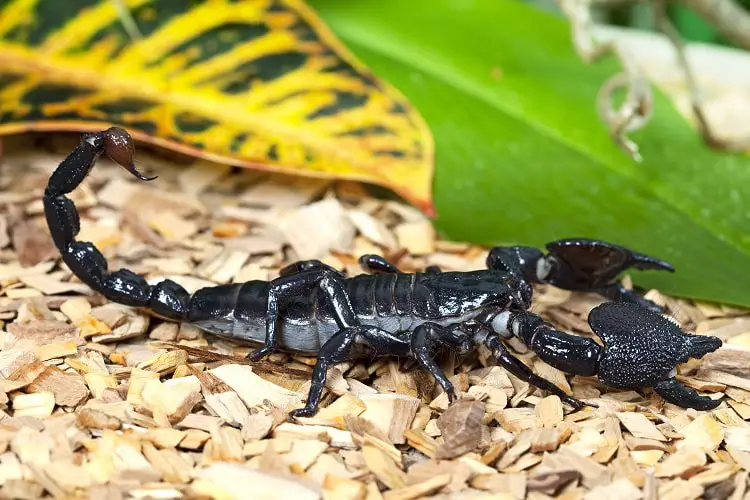
The cost of an emperor scorpion will fluctuate depending on certain factors. These factors are:
- Size of the scorpion
- The region the scorpion is being purchased in
- The gender of the scorpion
Currently, pet owners in the United States can obtain an emperor scorpion sized between three and eight inches for only $29.99.
On the other hand, pet owners in the United Kingdom can purchase a five to six cm juvenile for £120.00.
Most breeders and companies will not ship the emperor scorpion, instead requiring the new owner to pick their pet up from their business site.
Facts
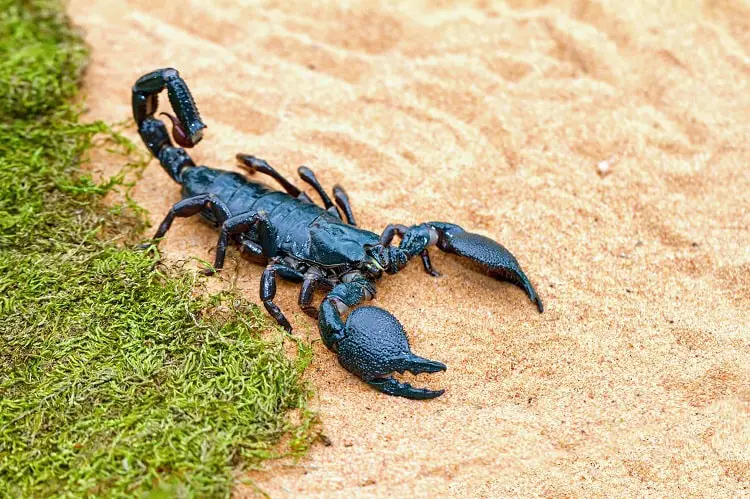
Common Name: Emperor Scorpion, Kaiser Skorpion
Scientific Name: Pandinus Imperator
Family Name: Scorpionidae
Genus Name: Pandinus
Range: Ghana, Togo, Nigeria, Democratic Republic of Congo, Ivory Coast, Guinea, Guinea-Bissau
Price: From $29.99
Size: 20 – 23 cm in length
Life Span: 5 -10 years in captivity
Tank Size: 10-gallon tank for single scorpion, 20-gallon and higher for a colony
Humidity & Temperature: 75% and 70 to 90 degrees Fahrenheit in temperature
Popular Alternative: Flat Rock Scorpion
Summary
With their impressive visage and gentle personality making them perfect for new owners, it is no wonder that the emperor scorpion is so popular.
Inexpensive to buy and accommodate other than the general set up of their enclosure, the emperor scorpion is a pet for those looking for companionship without interaction.
With the added option of keeping one or a colony of these majestic creatures, owning an emperor scorpion can only be described as a delight.
If you think these beautiful creatures are the ones for you, let us know in the comments.

I just bought an scorpion and the store told me the name is Emerald scorpion but I can’t find nothing with that name. If I send you a picture you will be able to figure which breed is??
Thanks
It seems that Emerald Scorpion is not an official or commonly used name. With all probability you have an Emperor Scorpion, but do try to send us a clear photo of your scorpion and we will do our best in identifying it